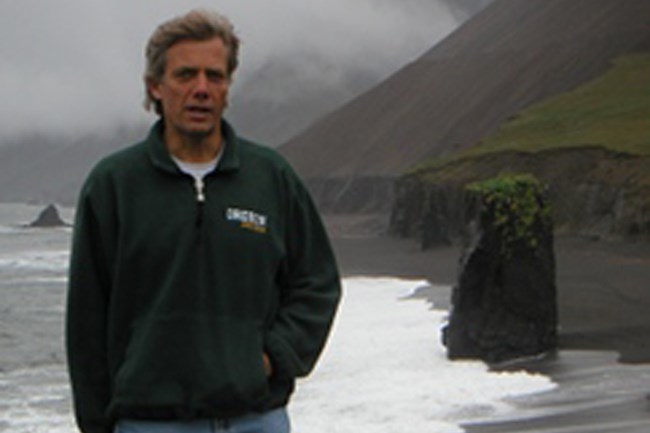
Chapter 9
Dr. Jon Erlandson, Professor of Anthropology, University of Oregon, describes his 2009 discovery of a cache of artifacts on San Nicolas Island.
Every time I go to the Channel Islands it seems like I find something that knocks my socks off. Finding a cache of redwood boxes on San Nicolas Island may be the most amazing of all.
This was a totally unexpected discovery. I was looking for ancient campsites along the coast, looking at old soils buried below younger sand dunes. I was walking along the edge of an eroding sea cliff and was in the right place at the right time.
I looked down and saw a whale rib sticking out of a fossil beach. Thinking the bone was a fossil I climbed down to have a look and was astounded to find an old redwood box buried under the long curved whale rib.
One side of the box had fallen off and when I looked inside I saw something shiny and picked out a piece of old green bottle glass. Then I picked out a soapstone bead, a brass button, and a carved soapstone effigy. Then I slapped myself on the head, thinking “You idiot, stop pulling things out of the box!”
I found my colleagues, and we changed our plans for the last 24 hours of our trip. The importance of the discovery was clear and the next big storm would have washed it into the ocean.
The next day, working on a narrow ledge above a steep sea cliff, we uncovered two old redwood boxes of classic Channel Islands construction, probably made from recycled canoe planks glued together with tar (asphaltum). Just outside the boxes, we found the remnants of several woven water bottles sealed with asphaltum.
The vast majority of the nearly 200 artifacts found in the two redwood boxes were probably made by Nicoleño people, including several arrowheads chipped from historic glass. I think the boxes were filled with tools, artifacts, and raw materials meant to be used later.
Who left them behind? We may never be able to answer that question definitively, but the age of the boxes suggests that it may well have been Juana María.
-
Listen to chapter 9 entry
Learn about an archeologist’s exciting discovery.
Chapter 17
Dr. Jon Erlandson, Professor of Anthropology, University of Oregon, talks about barbed projectile points he found in redwood boxes on San Nicolas Island in 2009.
In one of the boxes we found a ground slate blade and a bone harpoon, barbed on one side, with a line hole. I had worked in Alaska and the Pacific Northwest for many years and instantly recognized these as artifacts made by native peoples from the Oregon Coast up to the Aleutian Islands.
We also found a bone toggling harpoon with a copper blade still set in the tip. That was the clincher—this was a classic Aleut/Koniag [Alaska Native] artifact dating to the early historic period.
The harpoons are smaller than Alaska Natives used for hunting seals and sea lions, which leads me to believe they were for hunting sea otters. In the early 1800s, we know Russian fur traders brought Koniag hunters to San Nicolas Island, where they clashed with Juana María’s Nicoleño people.
-
Listen to chapter 17 entry
Learn about projectile points (harpoon tips) found on San Nicolas Island.
Last updated: December 13, 2018
